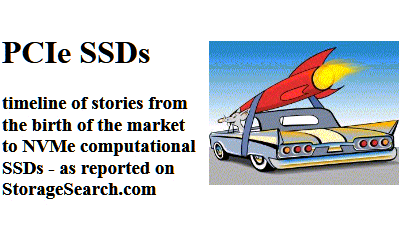SSD news - September
15-25, 2012 SSD history
SSD acquisitions
Decloaking
hidden segments in the enterprise |
| . |
How will IBM's acquisition of TMS impact
Fusion-io?
Editor:- September 25, 2012 - some of you may be
wondering - how will IBM's
acquisition of Texas
Memory Systems impact the pre-existing PCIe SSD business which IBM
already does with
Fusion-io?
Here
are my thoughts. (I've included reference links with more backgrounder details
as a footnote.)
In general the 2 different types of PCIe SSD - TMS vs
FIO - aren't the same and don't behave in the same way.
In some
situations there are strong arguments for users to prefer one product over
another - and vice versa. Furthermore - the present SSD card incumbent in the
IBM distribution store (Fusion-io) has some very sticky elements with respect to
the performance benefits delivered by its software APIs - which can't be
replicated by a substitute type of hardware product - no matter how fast its
raw hardware.
My gut feel, therefore is that as
the enterprise SSD market
is big enough to support both these 2 types of PCIe SSDs - it would be
illogical from a business perspective for IBM to withdraw or downgrade the
status of the Fusion-io product -so long as Fusion-io remains an independent
company.
In my view both product lines serve substantially different
market roles well - and the degree of overlap and cannibalization is small.
That's
not to say that the TMS product line will be deployed in equal numbers.
Far
from it - I would expect the TMS architecture to be the biggest part of IBM's
fast SSD business within a year of the acquisition - but that would be spread
across a range of product deployments which includes rackmount SSDs (from the
current TMS product line), and
Ram-San PCIe SSDs and
maybe removable 2.5"
PCIe SSDs (as a future roll-out of TMS technology).
Until IBM can
develop or acquire software products for the TMS SSD cards - which are on a par
with what FIO has to offer - then terminating the ioDrive options in its
catalog would be equivalent to sending its server customers to competing server
makers.
The effect either way would be neutral for Fusion-io's
business.
Here are some of the related article links which I promised
earlier.
...Later:- What happened to
the RamSan-70 and related TMS IP in PCIe SSDs?
IBM EOLed this product line.
As we learned later - they had other plans for server based SSD
acceleration as they were a collaborator in the needs requirements for
memory channel
SSDs.
RunCore launches fast PCIe SSD
Editor:-
September 24, 2012 - RunCore
today launched
its fastest yet PCIe SSD - the
Kylin III PCIe
- which has upto 1.4TB (usable) MLC capacity (full height, half length) R/W
bandwith of 3GB/s and 2GB/s respectively - and R/W IOPS upto 700K / 500K (with
4KB blocks) and 3 / 1.4 million IOPS (512B). Read latency is 65µS (512B).
Power consumption is under 15W (idle) and upto 50W (active).
Editor's
comments:- this new SSD from RunCore is in a different performance class
to earlier generations from the company which were frankly nowhere near the best
of breed in speed. Although
PCIe SSDs is now a
very crowded market - it gives buyers another viable (Top 20 SSD companies list)
supplier to choose from.
former BlueArc CEO, leaves HDS to steer Virident
Editor:-
September 20, 2012 - Confidence about the prospects for flash in the enterprise,
and a firm conviction that Virident is a key
player which will make a difference to the enterprise SSD market - set the
tone of the conversation I had on Monday with the company's new CEO Mike Gustafson
who was a few days into his new job and briefing me on Virident's
announcement
yesterday about his new appointment and the company's $26 million in Series D
Funding
The first thing I latched onto was the money. $26 million
doesn't seem like a lot - I said I'm sure they could have got more if they
wanted.
Mike said that's all they needed at this time - and he laughed
when I told him what my mother had said to me when I started a VC backed
company back in the 80s - It's easy borrowing money. It's harder paying it
back.
I asked Mike what the $26 million was for?
He said
they will be double the sales and marketing team in the next 12-18 months. Mike
said Virident's new business leads pipeline currently looks more like a case
of indigestion rather than starvation.
But Virident isn't going to rest
on the development side. There's still a lot of work to do in software and some
of the funds will be used for that.
Why did he leave HDS? I asked.
He said it was the opportunity to be the CEO of a company which is
already a leader in the enterprise SSD market and which can make a
significant difference to this disruptive industry.
Here are some of
the messages which came through about Virident's perspective of where they are
and their customer's thinking.
The light has come on in the marketplace
that flash is a disruptive technology and a game changer.
Despite how
long the SSD market has been around Virident cautiously sees this stage of the
SSD market as still being in the early phase of what it will achieve.
Shridar
Subramanian Virident's VP product marketing used a
cricket
metaphor to reinforce this - "Enterprise flash is still in the first
innings."
A lot of vendors talk about the "enterprise market"
but Mike said he had been lucky to be in previous organizations which had over
8,000 datacenter customers. One message coming from Virident's customers is
they're saying they realize now that when they see what flash can do that they
aren't being aggressive enough in their own flash adoption.
Another
message coming back is feedback about endurance. Some of Virident's customers
are extrapolating they will get 7 years of useful life. That means "it's
safe to get in the water" with true enterprise flash systems regardless of
the negative reputation of raw flash.
I said that Virident doesn't
say as much as I think it could about what it's doing. Mike and Shridar agreed
and said that will continue. Virident will only make bold claims of things they
can do and deliver.
Now to be fair to readers - I had such an
interesting conversation about the SSD market, the prospects for growth and the
importance of business and technology efficiencies - that I stopped taking notes
about half way through so I could keep up with the gist of what was being said.
I can't read my writing anyway. So my narrative above misses out many of the
things we discussed. But I think those are the important points.
PS
- I suppose - that given the 2 earlier SSD CEO changes this week in
OCZ and
STEC - I should
mention here that Virident's former CEO and co-founder Kumar Ganapathy
is remaining with the company to work on business strategy and new product
development.
Renice launches native USB 3 SSD with attached SCSI protocol
support
Editor:- September 20, 2012 - Renice Technology
launched a native USB
3 SSD (no bridge chips) using its own controller IP which supports the
UAS (USB
Attached SCSI) protocol, has SMART and
power
interruption data integrity protection and R/W speeds of 400MB/s and
320MB/s respectively.
which way now for OCZ?
Editor:- September
19, 2012 - For reasons which you can easily guess - in recent months
OCZ has replaced
STEC and Fusion-io as the
company which most SSD investors - who are contacting me for the first time -
ask most questions about. You can see what I've been thinking and saying on
this theme in OCZ's profile
page
OCZ's founder and CEO resigns
Editor:- September 17,
2012 - OCZ today
announced
the resignation of the company's founder and CEO Ryan
Petersen.
Alex Mei,
Executive VP and CMO has been named as Interim CEO, effective immediately. .
STEC's CEO stands down
Editor:- September 17, 2012 -
STEC today
announced
that Manouch Moshayedi, is stepping down from his positions as
Chairman and CEO pending resolution of a civil complaint filed against him by
the SEC, although he will remain with
the company, assuming the title of founder and continuing to serve as a member
of the board for the time being.
STEC's board today elected his brother
Mark Moshayedi, currently the President, COO and CTO of the company to be
interim CEO with effect from September 18, 2012. | |
| . |
 |
| . |
|

| |
|











